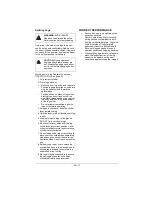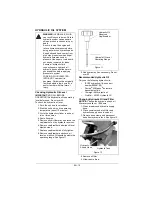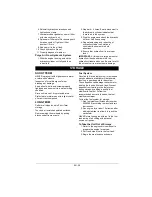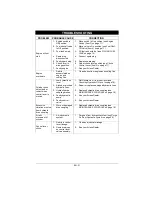
EN - 6
RULES FOR SAFE OPERATION
This cutting machine is capable of amputating
hands and feet and throwing objects. Failure
to observe the following safety instructions
could result in serious injury or death.
The following safety instructions are based
on recommendations found in ANSI standard
B71.7-2013 (Draft).
Never place hands or any
part of the body between a
log and any part of the log
splitter.
Hold logs on sides when
loading. Keep hands and
feet away from cylinder,
wedge, and partially split
logs.
Do not split logs against
the grain.
Split logs end to end in the
direction of the grain only.
2. WARNING!
To prevent serious injury or
death from escaping
hydraulic fluid:
•
ALWAYS keep body
and hands away
from pin holes or
nozzles which eject
hydraulic fluid under
pressure.
Escaping hydraulic fluid
can puncture skin and
cause blood poisoning.
3. WARNING!
Maximum towing speed of
45 mph (72.4 kph).
4. CAUTION!
No smoking, No sparks, No
flames.
Never fill fuel tank when
engine is running, hot or
unit is indoors.
Never overfill fuel tank.
Replace fuel cap
securely and clean up
spilled fuel.
MAX. 45mph (72.42kph)
Training
Only the user can prevent and is responsible
for accidents or injuries occurring to
themselves, other people or property.
Read the Operator's manual completely
before attempting to use this log splitter.
Do not allow anyone to operate your log
splitter who has not read the Operator's
Manual or has not been instructed on the
safe use of the splitter.
Never allow children or untrained adults to
operate this machine.
Many accidents occur when more than one
(1) person operates the log splitter. If a
helper is assisting in loading logs to be split,
never actuate controls until the helper is
clear of the area.
Never allow anyone to ride on the machine.
Never transport cargo on the log splitter.
High fluid pressures are developed in
hydraulic log splitters. Pressurize hydraulic
fluid escaping through a pin hole opening
can puncture skin and cause severe blood
poisoning. Therefore, the following
instructions should be heeded at all times.
(a) Do not operate the unit with frayed,
kinked, cracked or damaged hoses,
fittings, or tubing.
(b) Stop the engine and relieve
hydraulic system pressure before
changing or adjusting fittings, hoses,
tubing, or other system components.
(c) Do not adjust the pressure settings
of the pump or valve.
(d) Do not check for leaks with your
hand. leaks can be located by passing
cardboard or wood over the suspected
area. Look for discoloration. If injured
by escaping fluid, see a doctor at once.
Serious infection or reaction can
develop if proper medical treatment is
not administered immediately.
Keep the operator zone and adjacent area
clear for safe, secure footing.




























